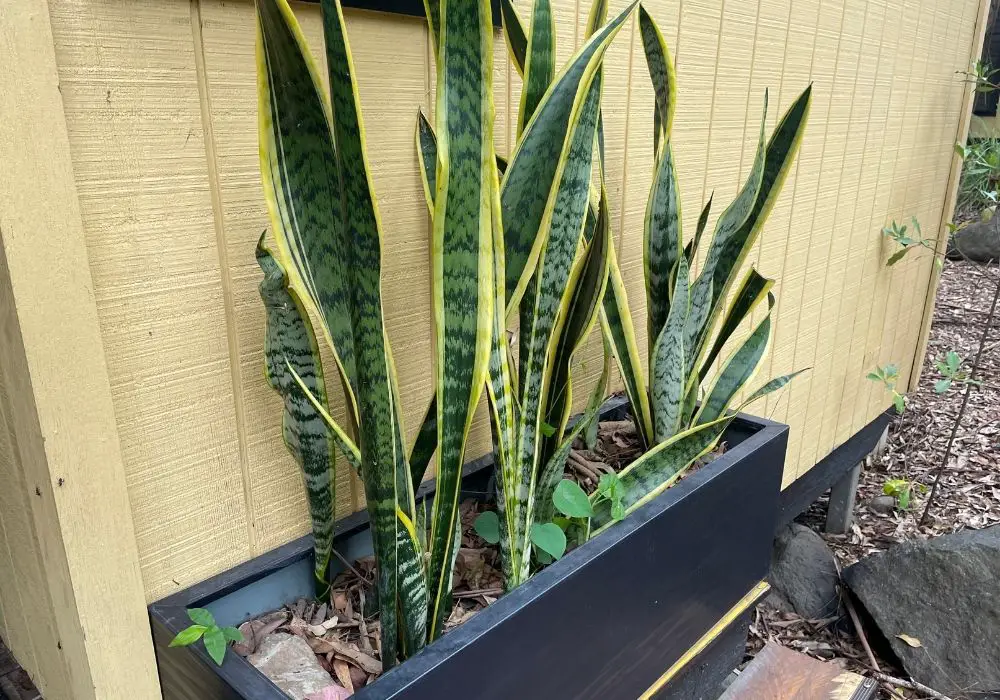Cylindrical snake plant (Dracaena Angolensis, synonym Sansevieria Cylindrica) also known as the African spear plant is a low maintenance plant, that requires infrequent watering, and can handle the full range of sun or light conditions and is quite happy being grown both as a houseplant indoors and outdoors. Basically, these plants are unkillable and an ideal plant for black thumbs, beginners and anyone else who likes braiding plants or just plain likes the look of them.
Cylindrical Snake Plant Quick Facts
| Common Names | African spear plant, cylindrical snake plant, spear sansevieria or Saint Bárbara sword (in Brazil) |
| Scientific Names | Dracaena Angolensis (synonym Sansevieria Cylindrica) |
| Plant Type | Succulent |
| Sun/Light | Prefers full sun or+8 hours filtered light, tolerable of low light conditions |
| Frost/Snow | Not tolerant of cold conditions, frost and snow will damage the plant. |
| Size | 4-6 feet outdoors planted in the ground, 2-3 ft indoors in a pot. |
| Water | Water deeply and infrequently, let the soil dry out fully between watering. |
| Soil | Good draining soil |
| Fertilizer | During the growing season fertilize with a half-strength succulent fertilizer monthly. |
| Pests & Diseases | Vine weevils, mealybugs, root rot |
| Toxicity | Toxic to people and pets |
| Growing Season | Spring |
| Propagation | Division/separation, leaf/stem cuttings |
Cylindrical Snake Plant Care Guide
The cylindrical snake plant needs very minimal attention for it to thrive. If you incorporate all of the following steps you will have a healthy plant in your care.
Sun/Light
These plants can handle a large range of sun and light conditions. They will grow best when grown in full sun outside or indoors with 8+ hours of filtered light.
They can handle low light spots if they have to, but to help it out you should rotate it to a spot in your house that receives more sunlight for a day every week or so.
Size
When grown outdoors this plant can grow over 6 feet high and can be as wide as it is allowed to grow. If grown in a pot indoors its height will be 2-3 feet and will only grow as wide as the pot is.
This plant will need to be re-potted every couple of years as it outgrows its pots. You can wait until you start seeing roots start showing up on the surface of the potting mix before you re-pot it.
Water
Cylindrical snake plants like to be watered infrequently and deeply, this will encourage propper root growth and the plant won’t become waterlogged and rot.
If kept indoors and in a pot, before watering check the top 1-2 inches of soil, if dry then you can water the plant. I water all of my indoor plants using the bottom-watering method. This promotes root growth in the bottom of the pot and doesn’t give fungus gnats a home to live in.
Fertilizer
These plants only need to be fertilized once a year, just at the start of the growing season in spring. That is another reason why these plants make such great beginner plants.
You can use just a regular succulent fertilizer mixed to half strength.
Pests & Diseases
Cylindrical snake plants are generally resistant to pests and diseases. If kept outside you should inspect your plants every few weeks to check on their health and to make sure there aren’t any vine weevils or mealybugs present.
If overwatered the plant could suffer from root rot which could be fatal.
Frost/Snow
These plants are not tolerant of temperatures below 5°C (41°F). So if there are going to be any prolonged periods of snow or frost for any cylindrical snake plants kept outside, if you can you should move them inside where they will stand a better chance of living.
The ideal temperature for this plant to thrive are:
- Daytime temperatures: 15°C (60°F) and 26°C (80°F)
- Nighttime temperatures: 12°C (55°F) and 21°C (70°F)
How To Braid An Cylindrical Snake Plant
I have only recently gotten my very own cylindrical snake plant which will need at least another year or two or growth before the stems are long enough to braid.
Here is a video I found on youtube which explains how to braid the stems of this plant. I am looking forward to when my stems are long enough to do this myself.
Cylindrical Snake Plant Propagation
Cylindrical snake plants are easily propagated using two methods; (1) the division/seperation method, of (2) by using a stem cutting.
7 Plants That Look Similar To The Cylindrical Snake Plants
Other plants from this same family that look similar to the Cylindrical snake plants are:
- Snake plant (Dracaena trifasciata synonym Sansevieria trifasciata)

- Birds nest snake plant (Sansevieria Hahnii)
- Pickle Plant (Senecio Stapeliiformis)
- Devil’s tongue
- Jinn’s tongue
- Bow string hemp
- Ox Tongue
Family/Genus
The cylindrical snake plants/African spear plants belong to the Asparagaceae family.
Historically the cylindrical snake plants were included in the Sansevieria genus which consisted of approximately 70 flowering plants that were native to Africa. After a phylogenetic study, it and the other plants in the Sansevieria genus now belong to the Dracaena genus.
There are a lot of blogs out there that are still using the old name Sansevieria Cylindrica for this plant, which is fine as everyone knows what they mean, but the correct name for these plants is Dracaena Angolensis.
Is The Cylindrical Snake Plant Toxic To Pets and Animals?
Unfortunately, this plant can be toxic to your pets or animals. If chewed and ingested it may cause your pets to suffer from nausea, vomiting, diarrhea and may also swell the tongue and throat of your pet.
So if your pets are likely to chew your cylindrical spear plants, place them up high out of their reach. Or better yet, just give it away to a home that doesn’t have pets.
Cylindrical Snake Plant/Dracaena Angolensis FAQs
Do Cylindrical Snake Plants Need a Special Soil/potting Mix?
Cylindrical snake plants prefer a well-draining potting mix. A succulent or cactus mix is ideal.
When Should the Tie on Top of A Braided Cylindrical Snake Plant Be Untied?
There is no reason to ever unbraid the stems, only to change their appearance or to rebraid the longer plant stems.
Can You Propagate Cylindrical Snake Plants?
Yes, you can propagate by either dividing an existing mature cylindrical snake plants rhizome or by stem cuttings in soil or water. See above my explanation on propagating the cylindrical snake plants.
Is Sansevieria Cylindrica poisonous to Cats and Dogs?
Yes, if ingested they can make your pets and animals nauseous and sick. Best that your pets don’t lick it either.
Why Is My Cylindrical Snake Plant Dying?
There are a few reasons why your cylindrical snake plants may be dying.
(1) Overwatering. The cylindrical snake plants like good draining soil, so if the soil is remaining soggy for too long, there is a chance that this will be fatal.
(2) Root rot. If it is being overwatered and water isn’t draining away properly, it may have root rot.
(3) Low temperatures or frost. Prolonged exposure to low temperatures below 10°C (50°F) can be fatal. These plants can only handle mild temperature fluctuations.
Can You Propagate Cylindrical Snake Plants Cuttings in Water?
Yes, you can propagate cylindrical snake plants in water. Simple once you get a cutting, place directly in a cut of water. In 2-3 months there will be a good amount of roots growing and the cutting will be ready to be planted in soil.
Change the water in the cup every 1-2 weeks to keep it fresh and prevent mould from growing.
What Are Cylindrical Snake Plants Good For?
Cylindrical snake plants are able to remove harmful toxic airborne pollutants. Some pollutants are cancer-causing including CO2, benzene, formaldehyde, xylene and toluene.
They can also convert carbon dioxide (CO2) into oxygen at night. This is a unique trait to snake plants.
How Often Should You Water Sansevieria Cylindrica?
Before watering, stick your finger in the top 1-1.5 inches of potting mix. If it is dry to touch then you should water it, if it still feels damp then don’t water it.
Final Thoughts
I hope you found this information on the cylindrical snake plant (Dracaena Angolensis) useful. I’ll be updating this content as I learn more about this plant so make sure you check my blog regularly for more information.


